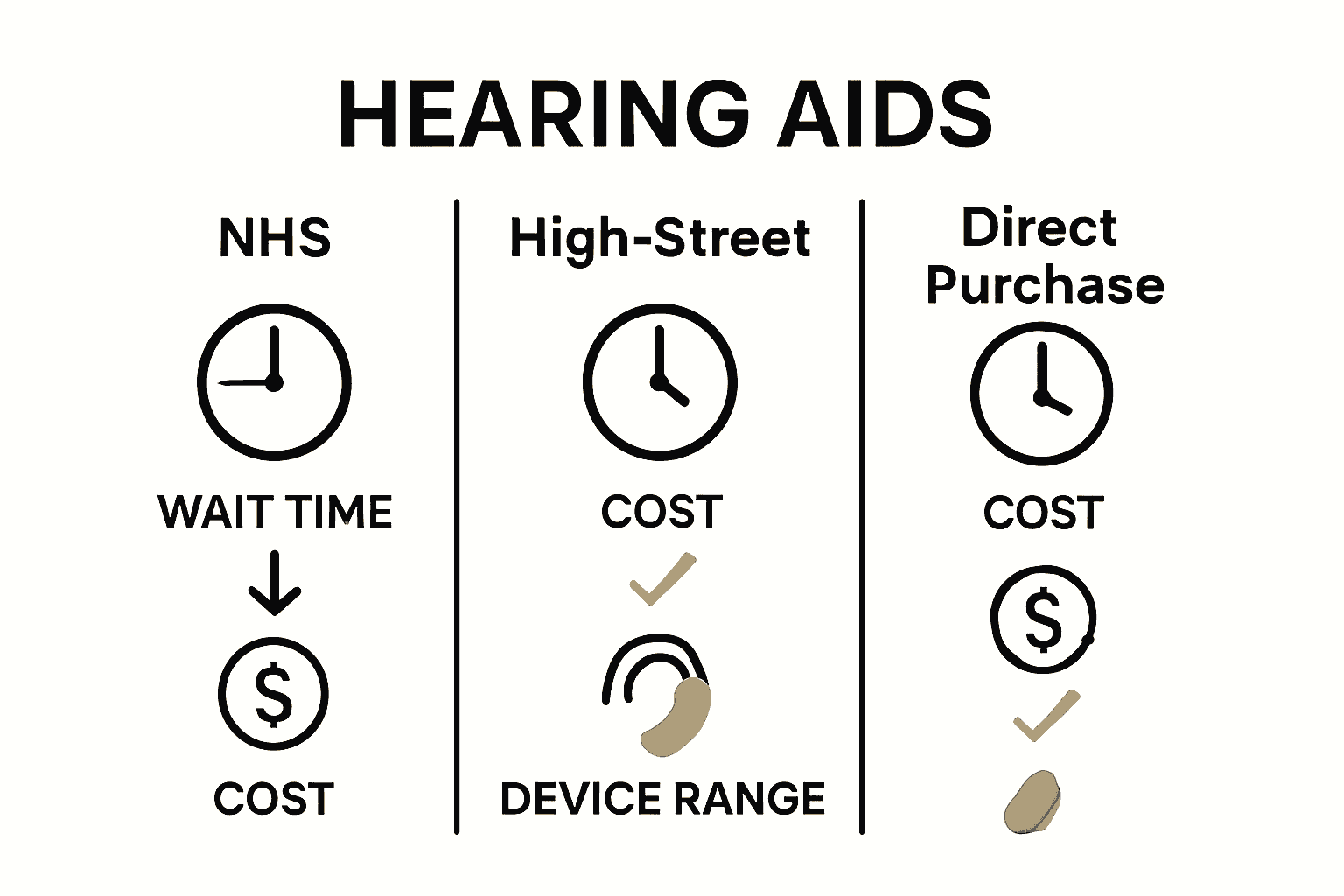Nearly 12 million people in the UK live with hearing loss, yet many are unaware of just how far hearing enhancement technology has advanced. With a wave of cutting-edge features like artificial intelligence, Bluetooth connectivity, and nearly invisible designs, today’s devices are transforming daily life for users. Exploring these innovations can help you understand how modern solutions go beyond basic amplification, offering a more comfortable and connected listening experience.
Table of Contents
- Defining Hearing Enhancement Technology Today
- Types of Modern Hearing Devices Explained
- How Digital Hearing Aids Operate
- Key Features of Advanced Hearing Solutions
- Comparing Clinic, High-Street, and Direct Models
- Costs, Safety, and Common Buyer Questions
Key Takeaways
| Point | Details |
|---|---|
| Advanced Digital Technology | Hearing enhancement technology employs sophisticated digital signal processing for personalized sound experiences, transforming conventional hearing aids into intelligent devices. |
| Diverse Device Options | Multiple types of modern hearing devices cater to various levels of hearing loss and user preferences, including BTE, ITE, CIC, and IIC models. |
| Purchasing Pathways | Consumers have varied options for acquiring hearing aids, including NHS services, private clinics, and direct-to-consumer models, each with specific advantages. |
| Cost and Safety Considerations | Potential buyers should weigh cost factors, safety, and technical aspects when selecting hearing aids to ensure a suitable fit for their needs. |
Defining Hearing Enhancement Technology Today
Hearing enhancement technology represents a sophisticated blend of advanced electronic engineering and auditory science designed to improve sound perception for individuals experiencing hearing difficulties. These intelligent devices go far beyond traditional hearing aids, transforming how people interact with sound in their everyday environments.
At its core, hearing enhancement technology utilizes sophisticated digital signal processing to amplify, clarify, and customise sound experiences. Modern devices incorporate microprocessors that can analyse incoming sound waves in milliseconds, distinguishing between speech, background noise, and environmental sounds. This means users receive a nuanced, adaptive listening experience tailored precisely to their specific hearing profile.
Key features of contemporary hearing enhancement technology include:
- Digital sound processing that filters and optimises audio signals
- Adaptive noise reduction capabilities
- Bluetooth connectivity for seamless smartphone integration
- Rechargeable battery systems with extended performance
- Compact, nearly invisible designs that prioritise user comfort
The evolution of hearing enhancement technology has been remarkable. Why Upgrade Hearing Technology: Complete Guide UK highlights how these devices have transitioned from bulky, one-size-fits-all solutions to intelligent, personalised hearing companions. Modern technology doesn’t just amplify sound - it creates a comprehensive auditory experience that restores confidence and improves communication for users.
Understanding these technologies means recognising they’re not just medical devices, but sophisticated tools that bridge communication gaps. Whether managing mild hearing loss or addressing more complex auditory challenges, hearing enhancement technology continues to push boundaries of what’s possible in sound perception and personal audio experience.
Types of Modern Hearing Devices Explained
Modern hearing devices have revolutionised auditory assistance, offering a diverse range of solutions tailored to individual hearing challenges. According to the NHS, contemporary hearing technologies include multiple device types designed to address varying levels of hearing loss and personal preferences.
The primary categories of hearing devices include:
- Behind-the-Ear (BTE) devices
- In-the-Ear (ITE) devices
- Completely-in-the-Canal (CIC) models
- Invisible-in-the-Canal (IIC) designs
From research by Sense, these hearing aids offer unique benefits depending on individual needs. For instance, BTE models provide robust amplification and are suitable for various hearing loss severities, while IIC devices offer maximum discretion for users prioritising aesthetic considerations.
Specialised hearing devices extend beyond traditional aids. Bone-anchored hearing aids (BAHA) and cochlear implants represent advanced solutions for individuals with more complex hearing challenges. For those experiencing single-sided deafness, CROS and BiCROS hearing aids provide innovative sound transmission technologies that help users perceive sounds from all directions.
Why Hearing Aids Are Discreet Now: Complete Guide highlights how modern hearing technologies prioritise user comfort and aesthetic appeal. Today’s devices are no longer bulky medical instruments but sophisticated, almost invisible tools that seamlessly integrate into users’ lifestyles, offering enhanced hearing experiences with unprecedented discretion and technological sophistication.

How Digital Hearing Aids Operate
Digital hearing aids represent a sophisticated technological breakthrough in auditory assistance, transforming how individuals experience sound. According to RNID, these devices function through an intricate process of sound capture, digital processing, and precise amplification tailored to individual hearing profiles.
The core operational mechanism involves several critical stages:
- Sound Capture: Sensitive microphones collect environmental sounds
- Digital Signal Processing: Advanced microprocessors analyse and filter audio signals
- Sound Amplification: Customised sound waves are transmitted through the speaker
- Output Adjustment: Real-time modifications based on listening environment
The NHS confirms that digital hearing aids excel at distinguishing between speech and background noise, a capability that sets them apart from traditional analog devices. This intelligent filtering means users can focus on conversations more effectively, reducing auditory fatigue and improving overall communication experience.
Modern digital hearing aids go beyond simple amplification. They incorporate sophisticated features like directional microphones, feedback suppression, and even Bluetooth connectivity. Rechargeable Hearing Aids Tutorial: Easy Setup and Use Guide highlights how these devices have become compact, intelligent companions that adapt seamlessly to users’ changing acoustic environments. Whether in a quiet room or a bustling restaurant, digital hearing aids continuously optimise sound quality, providing users with a more natural and comfortable listening experience.
Key Features of Advanced Hearing Solutions
Advanced hearing solutions represent a transformative leap in auditory technology, offering users unprecedented control and personalisation in their hearing experience. Modern devices go far beyond simple sound amplification, integrating intelligent technologies that adapt dynamically to complex listening environments.
Key technological features include:
- Artificial Intelligence (AI) Sound Processing
- Multi-Environment Sound Adaptation
- Bluetooth and Smartphone Connectivity
- Noise Reduction Technologies
- Rechargeable Battery Systems
- Invisible and Discreet Design Options
These sophisticated hearing solutions are engineered to provide seamless auditory experiences across diverse settings. From quiet home environments to noisy public spaces, advanced hearing devices continuously analyse and adjust sound parameters in real-time, ensuring optimal clarity and comfort. 7 Simple Ways to Spot Quality Hearing Aids Fast demonstrates the importance of understanding these cutting-edge technological capabilities when selecting the right hearing enhancement device.
The most innovative hearing solutions now incorporate smartphone app integration, allowing users to fine-tune their listening experience through intuitive digital controls. Personalisation has become a cornerstone of modern hearing technology, with devices capable of learning individual user preferences, automatically adjusting to specific acoustic environments, and providing granular control over sound enhancement settings. This represents a profound shift from traditional, one-size-fits-all hearing assistance towards truly individualised auditory support.
Comparing Clinic, High-Street, and Direct Models
Hearing aid acquisition has evolved dramatically, presenting consumers with multiple purchasing pathways. According to the NHS, individuals now have three primary options: NHS services, private clinics, and direct-to-consumer models, each with distinct advantages and limitations.
The key differences between these models include:
-
NHS Model
- Free hearing aids
- Comprehensive follow-up care
- Longer waiting periods
- Limited device selection
-
High-Street Providers
- Wider device range
- Faster service
- Higher out-of-pocket costs
- Personalised fitting options
-
Direct Purchase Models
- Most affordable pricing
- Immediate device access
- Reduced professional consultation
- Streamlined online experience
Research from RNID reveals that while NHS services offer free support, private and direct models provide faster access and more personalised solutions. These alternative purchasing methods have democratised hearing technology, giving consumers greater control over their hearing health.
7 Simple Ways to Spot Quality Hearing Aids Fast highlights the importance of understanding these different acquisition models. Modern consumers increasingly value convenience, affordability, and technological sophistication, driving a shift towards more flexible and user-centric hearing solutions that prioritise individual needs over traditional, one-size-fits-all approaches.

Costs, Safety, and Common Buyer Questions
Hearing aid purchasing involves navigating complex considerations of affordability, safety, and personal comfort. According to the NHS, hearing aid costs can range dramatically, from completely free NHS options to private solutions costing several thousand pounds, making informed decision-making crucial for potential buyers.
Common buyer concerns typically centre around:
-
Cost Considerations
- NHS free hearing aid options
- Private sector pricing ranges
- Long-term maintenance expenses
- Insurance and warranty coverage
-
Safety Factors
- Proper device fitting
- Regular maintenance requirements
- Preventing potential ear infections
- Adjustment period management
-
Technical Questions
- Battery life expectations
- Compatibility with smartphones
- Noise reduction capabilities
- Personalisation options
Research from RNID emphasises the importance of understanding the adjustment period and maintenance requirements when selecting hearing aids. Buyers should anticipate an initial adaptation phase where their auditory system learns to process sounds through the new device.
7 Simple Ways to Spot Quality Hearing Aids Fast provides additional guidance for consumers navigating these complex purchasing decisions. Ultimately, the right hearing solution balances individual hearing needs, budget constraints, and technological sophistication to deliver a personalised auditory experience.
Discover Smart Hearing Enhancement with Audora Today
If you are seeking effective hearing enhancement technology that goes beyond traditional solutions, Home page – Audora offers a perfect blend of innovation and convenience. The pain of long waits for NHS appointments or the high cost of clinic hearing aids is a challenge Audora understands deeply. With our UKCA-certified digital hearing devices featuring AI sound processing, rechargeable batteries, and nearly invisible designs, you can regain confidence in your hearing without compromising on style or comfort.

Take control of your hearing journey now by exploring high-quality, discreet hearing aids available at significantly lower prices. Visit GetAudora.co.uk for transparent pricing and full support. This is your opportunity to access state-of-the-art hearing enhancement technology swiftly and safely. Don’t wait for better hearing to happen – make it happen today.
Frequently Asked Questions
What is hearing enhancement technology?
Hearing enhancement technology refers to advanced electronic devices designed to improve sound perception for individuals with hearing difficulties. These technologies use digital signal processing to amplify and clarify sounds, providing a customized auditory experience.
How do digital hearing aids work?
Digital hearing aids capture sound using sensitive microphones, process the audio through advanced microprocessors, and amplify the sound tailored to the user’s hearing profile. They excel at distinguishing speech from background noise, enhancing the listening experience significantly.
What are the different types of modern hearing devices?
Modern hearing devices include Behind-the-Ear (BTE) aids, In-the-Ear (ITE) aids, Completely-in-the-Canal (CIC) aids, and Invisible-in-the-Canal (IIC) aids. Each type offers unique benefits based on the severity of hearing loss and user preferences.
What features should I look for in an advanced hearing solution?
Key features to consider in advanced hearing solutions include artificial intelligence sound processing, Bluetooth connectivity, noise reduction technologies, rechargeable battery systems, and discreet designs that enhance user comfort while maintaining aesthetic appeal.

